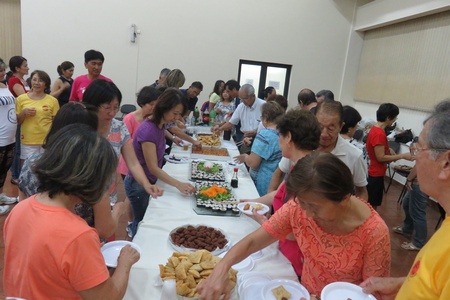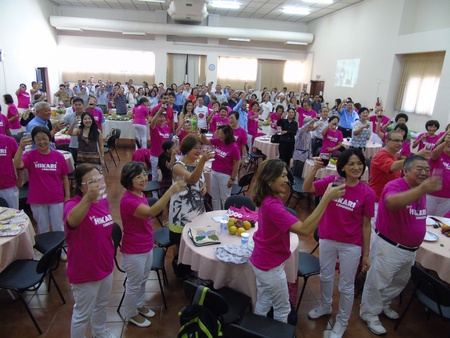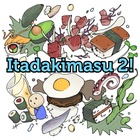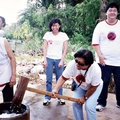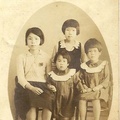Japanese immigrants came to Brazil in the last century to work on coffee plantations with the dream of becoming rich and then returning to Japan. Faced with the difficulties encountered and, realizing that it would not be possible to make this dream come true, they began the process of integration with the Brazilians ( gaijin ).
Little by little they adapted to the customs, cuisine, religious beliefs and lifestyle of the people here. But in family life, they preserved their culture, especially when the younger generations lived with elderly people concerned about passing on Japanese values, customs, language and cuisine.
The eating habits brought by the first immigrants based on shirogohan, white rice prepared without any seasoning, miso soup made with fermented soybean paste, moti made with pounded motigome rice, natô made with fermented soybean grains, tsukemono, a type of preserve prepared with ginger ( shoga ), carrots ( ninjin ), chard (hakussai ) and other vegetables, sashimi , based on raw fish, were considered exotic, strange and little appreciated by non-Nikkei.
Today, Japanese cuisine is on the rise in Brazil, with some adaptations to Western tastes and has been gaining tradition and prestige, as it is a healthy option, considering the quality and life expectancy of the Japanese. It is possible to enjoy it in typical restaurants or restaurants associated with the cuisine of other oriental cultures, such as Chinese and Korean, in fast foods , food trucks , steakhouses and other gastronomy spaces in any region of the country.
In Londrina, in the north of Paraná, Japanese restaurants have become a success among Nikkei and non-Nikkei alike, who can handle with incredible ease the previously exotic chopsticks that replace the fork – chopsticks – to eat sushi, sashimi, miso soup, tempurá , shirogohan , in addition to salads with soy sauce and other typical ingredients.
The arrival of immigrants allowed the incorporation of a variety of fruits and vegetables, such as persimmons, apples, pears, chard, Japanese spinach, bean sprouts, bamboo shoots, radishes, cabotiá pumpkin, among a diversity of products, enriching the cuisine Japanese-Brazilian.
We are part of the Londrina Hikari Group, which brings together Nikkei and non-Nikkei of both sexes to train bon odori weekly in the city of Londrina. In addition to training, the group usually participates in the festivities of bonenkai - the end of the year get-together, shinenkai - the beginning of the year get-together, and tandyokai, to celebrate the birthdays of the group's participants.
At these meetings, each member usually prepares a sweet or savory delicacy and shares it with everyone, giving everyone the opportunity to try different types of food. Widely adopted by the Japanese-Brazilian community, this apparently simple tradition, known as motiyori , is one of those responsible for preserving several aspects of Japanese culture, including the custom of making a toast with the word Banzai and the use of the expressions Itadakimasu and Gochisoosama before and after people serve themselves.
It is the opportunity to taste onishimê , tsukemono , sushi, hijiki gohan , harussame, mandiu, moti, kanten and other Japanese cuisine dishes and also those prepared with beef, fish and chicken, pasta, vegetables in a variety of flavors , typical of Brazilian cuisine.
The custom of motiyori , in addition to not weighing down the pockets of organizers or participants, is a great example of solidarity, promoting unity and greater integration between people. Tasting food prepared by a friend, neighbor or relative intensifies the atmosphere of intimacy, it is as if the dining room were everyone's home – not to mention the pleasure of being able to enjoy good food prepared at home.
We did not get to count the proportion between Japanese and Brazilian cuisine in these meetings, but we found that the group still retains many of the eating habits of their parents and grandparents who came to Brazil in the last century.
Due to the insertion of women in the job market and perhaps little interest in the activity, the number of people who handcraft ingredients such as tofu, miso, natô, tsukemono and moti at home is decreasing. Families prefer to go to specialized restaurants or purchase these ready-made products in markets, grocery stores or fairs.
Exchanging food recipes is a common custom among Hikari Group participants, hence the idea of publishing a recipe book. As most people don't have much time to spend in the kitchen, we opted for a selection of easy-to-cook dishes. prepare to be consumed on a daily basis and be economical. Others, more elaborate, were also included, which are usually served at festive events or when we get together to carry out group work for the purpose of philanthropy.
Everyone in the group was invited to collaborate on at least one sweet or savory recipe, without it necessarily being part of Japanese cuisine. The book, which is in the editing phase, contains several recipes that include soy sauce , sake , hondashi , gobu (seaweed), su (vinegar), shoga (ginger), goma (sesame), aji no moto , wasabi and kamaboko as ingredients. This fact served to demonstrate that the bases of Japanese cuisine are present in the group.
According to a Gastronomy scholar, one culture does not come into contact with another without transforming itself. The result of this are sushi options prepared with cream cheese, mayonnaise, strawberry, avocado or mango, fried sushi , croquettes using okara - soy cheese residue, harumaki stuffed with guava and cheese, pastries with takenoko filling ( bamboo shoot), tofu (soy cheese), seasoned with olive oil and black pepper, in short, an infinite number of dishes in which ingredients from Japanese and Brazilian cuisine are mixed.
Dishes like the “Philadelphia roll” made with salmon, avocado and cream cheese may please Brazilians, but they are rarely found in typically Japanese restaurants.
In the period before and during the Second World War, faced with the lack of umeboshi , a preserve similar to plums widely consumed in Japan, immigrants found the reddish-colored hibiscus fruit to be an alternative preserve to eat with shirogohan here in Brazil.
At weekly bon odori training meetings , ban-tea and coffee are served during class breaks, while some prefer the first one served without sugar, others don't give up the traditional Brazilian coffee.
As time passes, the eating habits of the children, grandchildren and great-grandchildren of Hikari participants are also changing as a result of the integration of the two cultures.
Therefore, it is natural that the younger generations born in Brazil like rice with beans, steak, fries and salad, feijoada, barbecue or pizza, characteristic of local cuisine, but it is likely that part of this generation prefers white rice – shirogohan , made in the electric cooker with traditional seasoned rice, yakisakaná , grilled fish with traditional steak, miso soup, instead of soup, sashimi , based on raw fish, tamagoyaki , Japanese omelet, and other options.
Japanese cuisine is transforming to adapt to Brazilian tastes, but in our opinion, the roots must be preserved by the Nikkei, preventing it from being practiced outside the original characteristics of use, handling and conservation of products.
© 2017 Alba Shioco Hino, Nilza Matiko Iwakura Okano, Kiyomi Nakanishi Yamada






